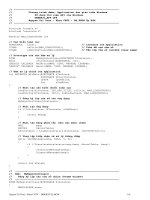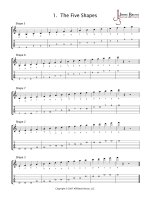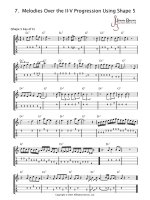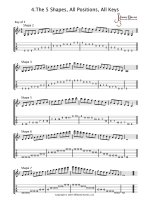10 5 numth annotated tủ tài liệu bách khoa
Bạn đang xem bản rút gọn của tài liệu. Xem và tải ngay bản đầy đủ của tài liệu tại đây (236.15 KB, 10 trang )
Online
Cryptography
Course
Dan
Boneh
Intro.
Number
Theory
Intractable
problems
Dan
Boneh
Easy
problems
• Given
composite
N
and
x
in
ZN
find
x-‐1
in
ZN
• Given
prime
p
and
polynomial
f(x)
in
Zp[x]
find
x
in
Zp
s.t.
f(x)
=
0
in
Zp
(if
one
exists)
Running
Lme
is
linear
in
deg(f)
.
…
but
many
problems
are
difficult
Dan
Boneh
Intractable
problems
with
primes
Fix
a
prime
p>2
and
g
in
(Zp)*
of
order
q.
Consider
the
funcLon:
x
⟼
gx
in
Zp
Now,
consider
the
inverse
funcLon:
Dlogg
(gx)
=
x
where
x
in
{0,
…,
q-‐2}
Example:
in
:
1,
2,
3,
4,
5,
6,
7,
8,
9,
10
Dlog2(⋅)
:
0,
1,
8,
2,
4,
9,
7,
3,
6,
5
Dan
Boneh
DLOG:
more
generally
Let
G
be
a
finite
cyclic
group
and
g
a
generator
of
G
G
=
{
1
,
g
,
g2
,
g3
,
…
,
gq-‐1
}
(
q
is
called
the
order
of
G
)
Def:
We
say
that
DLOG
is
hard
in
G
if
for
all
efficient
alg.
A:
Pr
g⟵G,
x
⟵Z
[
A(
G,
q,
g,
gx
)
=
x
]
<
negligible
q
Example
candidates:
(1)
(Zp)*
for
large
p,
(2)
EllipLc
curve
groups
mod
p
Dan
Boneh
CompuLng
Dlog
in
(Zp)*
(n-‐bit
prime
p)
Best
known
algorithm
(GNFS):
run
Lme
exp(
)
cipher
key
size
80
bits
128
bits
256
bits
(AES)
modulus
size
1024
bits
3072
bits
15360
bits
EllipLc
Curve
group
size
160
bits
256
bits
512
bits
As
a
result:
slow
transiLon
away
from
(mod
p)
to
ellipLc
curves
Dan
Boneh
An
applicaLon:
collision
resistance
Choose
a
group
G
where
Dlog
is
hard
(e.g.
(Zp)*
for
large
p)
Let
q
=
|G|
be
a
prime.
Choose
generators
g,
h
of
G
For
x,y
∈
{1,…,q}
define
H(x,y)
=
gx
⋅
hy
in
G
Lemma:
finding
collision
for
H(.,.)
is
as
hard
as
compuLng
Dlogg(h)
Proof:
Suppose
we
are
given
a
collision
H(x0,y0)
=
H(x1,y1)
then
gx0⋅hy0
=
gx1⋅hy1
⇒
gx0-‐x1
=
hy1-‐y0
⇒
h
=
g
x0-‐x1/y1-‐y0
Dan
Boneh
Intractable
problems
with
composites
Consider
the
set
of
integers:
(e.g.
for
n=1024)
:=
{
N
=
p⋅q
where
p,q
are
n-‐bit
primes
}
Problem
1:
Factor
a
random
N
in
(e.g.
for
n=1024)
Problem
2:
Given
a
polynomial
f(x)
where
degree(f)
>
1
and
a
random
N
in
find
x
in
s.t.
f(x)
=
0
in
Dan
Boneh
The
factoring
problem
Gauss
(1805):
“The
problem
of
dis0nguishing
prime
numbers
from
composite
numbers
and
of
resolving
the
la8er
into
their
prime
factors
is
known
to
be
one
of
the
most
important
and
useful
in
arithme0c.”
Best
known
alg.
(NFS):
run
Lme
exp(
)
for
n-‐bit
integer
Current
world
record:
RSA-‐768
(232
digits)
• Work:
two
years
on
hundreds
of
machines
• Factoring
a
1024-‐bit
integer:
about
1000
Lmes
harder
⇒
likely
possible
this
decade
Dan
Boneh
Further
reading
• A
ComputaLonal
IntroducLon
to
Number
Theory
and
Algebra,
V.
Shoup,
2008
(V2),
Chapter
1-‐4,
11,
12
Available
at
//shoup.net/ntb/ntb-v2.pdf
Dan
Boneh
End
of
Segment
Dan
Boneh









